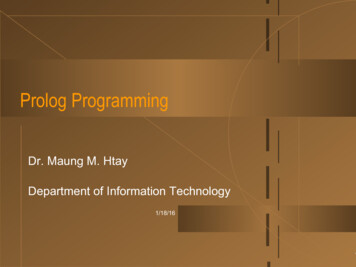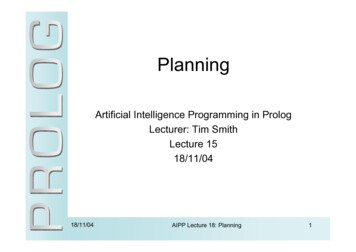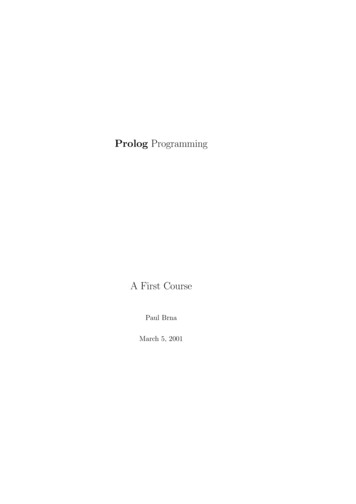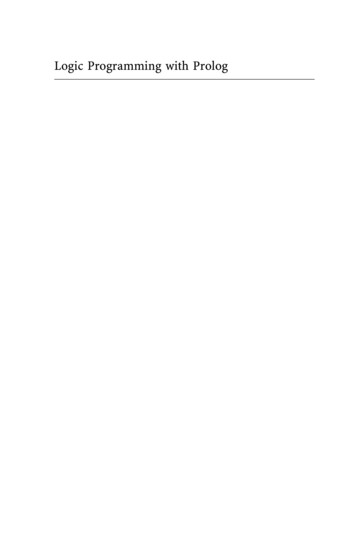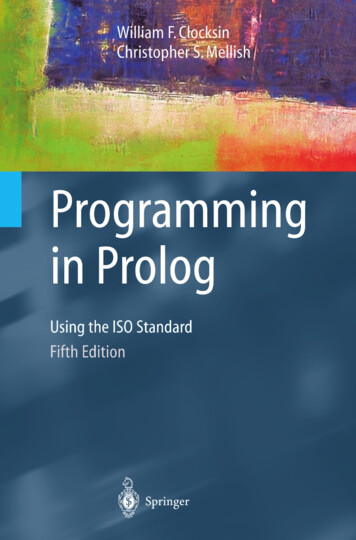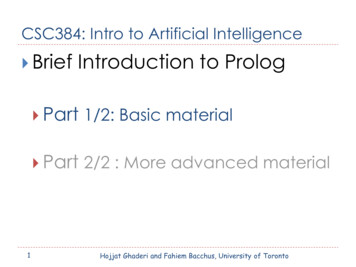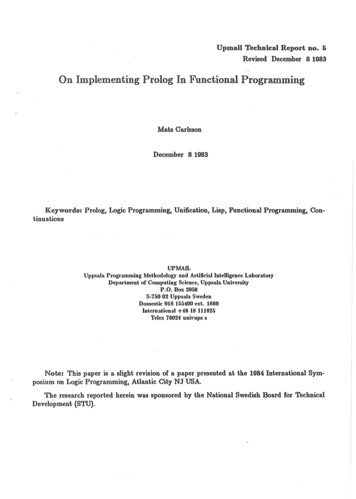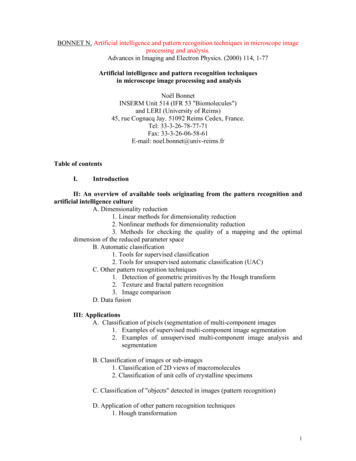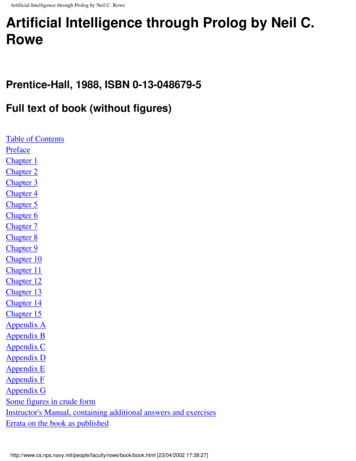
Transcription
Artificial Intelligence through Prolog by Neil C. RoweArtificial Intelligence through Prolog by Neil C.RowePrentice-Hall, 1988, ISBN 0-13-048679-5Full text of book (without figures)Table of ContentsPrefaceChapter 1Chapter 2Chapter 3Chapter 4Chapter 5Chapter 6Chapter 7Chapter 8Chapter 9Chapter 10Chapter 11Chapter 12Chapter 13Chapter 14Chapter 15Appendix AAppendix BAppendix CAppendix DAppendix EAppendix FAppendix GSome figures in crude formInstructor's Manual, containing additional answers and exercisesErrata on the book as /rowe/book/book.html [23/04/2002 17:38:27]
k/tableconts.htmlTable of contentsPrefaceAcknowledgementsTo the reader1. Introduction1.1 What artificial intelligence is about1.2 Understanding artificial intelligence1.3 Preview2. Representing facts2.1 Predicates and predicate expressions2.2 Predicates indicating types2.3 About types2.4 Good naming2.5 Property predicates2.6 Predicates for relationships2.7 Semantic networks2.8 Getting facts from English descriptions2.9 Predicates with three or more arguments2.10 Probabilities2.11 How many facts do we need?3. Variables and owe/book/tableconts.html (1 of 8) [23/04/2002 17:38:31]
k/tableconts.html3.1 Querying the facts3.2 Queries with one variable3.3 Multi-directional queries3.4 Matching alternatives3.5 Multi-condition queries3.6 Negative predicate expressions3.7 Some query examples3.8 Loading a database3.9 Backtracking3.10 A harder backtracking example: superbosses3.11 Backtracking with "not"s3.12 The generate-and-test scheme3.13 Backtracking with "or"s (*)3.14 Implementation of backtracking3.15 About long examples4. Definitions and inferences4.1 Rules for definitions4.2 Rule and fact order4.3 Rules as programs4.4 Rules in natural language4.5 Rules without right sides4.6 Postponed binding4.7 Backtracking with rules4.8 Transitivity inferences4.9 Inheritance inferences4.10 Some implementation problems for transitivity and inheritance4.11 A longer example: some traffic laws4.12 Running the traffic lights program4.13 Declarative programming5. Arithmetic and lists in Prolog5.1 Arithmetic ty/rowe/book/tableconts.html (2 of 8) [23/04/2002 17:38:31]
c assignmentReversing the "is"Lists in PrologDefining some list-processing predicatesList-creating predicatesCombining list predicatesRedundancy in definitionsAn example: dejargonizing bureaucratese (*)6. Control structures for rule-based systems6.1 Backward-chaining control structures6.2 Forward chaining6.3 A forward chaining example6.4 Hybrid control structures6.5 Order variants6.6 Partitioned control structures6.7 Meta-rules6.8 Decision lattices6.9 Concurrency in control structures6.10 And-or-not lattices6.11 Randomness in control structures6.12 Grammars for interpreting languages (*)7. Implementation of rule-based systems7.17.27.37.47.57.67.77.87.9Implementing backward chainingImplementing virtual facts in cachingInput codingOutput codingIntermediate predicatesAn example programRunning the example programPartitioned rule-based systemsImplementing the rule-cycle we/book/tableconts.html (3 of 8) [23/04/2002 17:38:31]
.187.19Implementing pure forward chaining (*)Forward chaining with "not"s (*)General iteration with "forall" and "doall" (*)Input and output of forward chaining (*)Rule form conversions (*)Indexing of predicates (*)Implementing meta-rules (*)Implementing concurrency (*)Decision lattices: a compilation of a rule-based system (*)Summary of the code described in the chapter (*)8. Representing uncertainty in rule-based systems8.1 Probabilities in rules8.2 Some rules with probabilities8.3 Combining evidence assuming statistical independence8.4 Prolog implementation of independence-assumption "and-combination"8.5 Prolog implementation of independence-assumption "or-combination"8.6 The conservative approach8.7 The liberal approach and others8.8 Negation and probabilities8.9 An example: fixing televisions8.10 Graphical representation of probabilities in rule-based systems8.11 Getting probabilities from statistics8.12 Probabilities derived from others8.13 Subjective probabilities8.14 Maximum-entropy probabilities (*)8.15 Consistency (*)9. Search9.19.29.39.4Changing worldsStatesThree /faculty/rowe/book/tableconts.html (4 of 8) [23/04/2002 17:38:31]
k/tableconts.html9.5 Search as graph traversal9.6 The simplest search strategies: depth-first and breadth-first9.7 Heuristics9.8 Evaluation functions9.9 Cost functions9.10 Optimal-path search9.11 A route-finding example9.12 Special cases of search9.13 How hard is a search problem?9.14 Backward chaining versus forward chaining (*)9.15 Using probabilities in search (*)9.16 Another example: visual edge-finding as search (*)10. Implementing search10.1 Defining a simple search problem10.2 Defining a search problem with fact-list states10.3 Implementing depth-first search10.4 A depth-first example10.5 Implementing breadth-first search10.6 Collecting all items that satisfy a predicate expression10.7 The cut predicate10.8 Iteration with the cut predicate (*)10.9 Implementing best-first search (*)10.10 Implementing A* search (*)10.11 Implementing search with heuristics (*)10.12 Compilation of search (*)11. Abstraction in search11.111.211.311.411.5Means-ends analysisA simple examplePartial state descriptionImplementation of means-ends analysisA harder example: flashlight we/book/tableconts.html (5 of 8) [23/04/2002 17:38:31]
k/tableconts.html11.611.711.811.9Running the flashlight programMeans-ends versus other search methodsModeling real-word uncertainty (*)Procedural nets (*)12. Abstraction of facts12.1 Partitioning facts12.2 Frames and slots12.3 Slots qualifying other slots12.4 Frames with components12.5 Frames as forms: memos12.6 Slot inheritance12.7 Part-kind inheritance12.8 Extensions versus intensions12.9 Procedural attachment12.10 Frames in Prolog12.11 Example of a frame lattice12.12 Expectations from slots12.13 Frames for natural language understanding (*)12.14 Multiple inheritance (*)12.15 A multiple inheritance example: custom operating systems (*)13. Problems with many constraints13.1 Two examples13.2 Rearranging long queries without local variables13.3 Some mathematics13.4 Rearranging queries with local variables13.5 Rearranging queries based on dependencies13.6 Summary of guidelines for optimal query arrangements13.7 Rearrangement and improvement of the photo interpretation query13.8 Dependency-based backtracking13.9 Reasoning about possibilities13.10 Using relaxation for the photo interpretation owe/book/tableconts.html (6 of 8) [23/04/2002 17:38:31]
ntifying the effect (*)Formalization of pure relaxationAnother relaxation example: cryptarithmeticImplementation of pure relaxation (*)Running a cryptarithmetic relaxation (*)Implementing double relaxation (*)14. A more general logic ical limitations of PrologThe logical (declarative) meaning of Prolog rules and factsExtending Prolog rulesMore about clause formResolutionResolution with variablesThree important applications of resolutionResolution search strategiesImplementing resolution without variables (*)15. Testing and debugging of artificial intelligence programs15.1 The gold standard15.2 Cases15.3 Focusing on bugs15.4 Exploiting pairs of similar cases15.5 Composite results15.6 Numbers in comparisons15.7 Preventive measures15.8 Supporting intuitive debugging15.9 Evaluating cooperativeness15.10 On problems unsuitable for artificial lty/rowe/book/tableconts.html (7 of 8) [23/04/2002 17:38:31]
k/tableconts.htmlAppendix A: basics of logicAppendix B: Basics of recursionAppendix C: Basics of data structuresAppendix D: summary of the Prolog dialect used in this bookD.1 Managing facts and rulesD.2 The format of facts, rules and queriesD.3. Program layoutD.4. ListsD.5. NumbersD.6. Output and inputD.7. StringsD.8. Treating rules and facts as dataD.9. Miscellaneous predicatesD.10. Definable predicatesD.11. DebuggingAppendix E: Using this book with Micro-PrologAppendix F: For further readingAppendix G: Answers to selected /rowe/book/tableconts.html (8 of 8) [23/04/2002 17:38:31]
k/preface.htmlPrefaceArtificial intelligence is a hard subject to learn. I have written a book to make it easier. I explain difficultconcepts in a simple, concrete way. I have organized the material in a new and (I feel) clearer way, a wayin which the chapters are in a logical sequence and not just unrelated topics. I believe that with this book,readers can learn the key concepts of artificial intelligence faster and better than with other books. Thisbook is intended for all first courses in artificial intelligence at the undergraduate or graduate level,requiring background of only a few computer science courses. It can also be used on one's own.Students often complain that while they understand the terminology of artificial intelligence, they don'thave a gut feeling for what's going on or how you apply the concepts to a situation. One cause is thecomplexity of artificial intelligence. Another is the unnecessary baggage, like overly formal logicalcalculi, that some books and teachers saddle students with. But an equally important cause is the oftenpoor connection made between abstract concepts and their use. So I considered it essential to integratepractical programming examples into this book, in the style of programming language and data structuresbooks. (I stress practical, not missionaries and cannibals, definitions of "grandfather", or rules foridentifying animals in zoos--at least rarely.) This book has about 500 chunks of code. Clear, concreteformalization of artificial intelligence ideas by programs and program fragments is all the more criticaltoday with commercialization and media discovery of the field, which has caused a good deal ofthrowing around of artificial intelligence terms by people who don't understand them.But artificial intelligence is a tool for complex problems, and its program examples can easily beforbiddingly complicated. Books attempting to explain artificial intelligence with examples from theprogramming language Lisp have repeatedly demonstrated this. But I have come to see that the fault liesmore with Lisp than with artificial intelligence. Lisp has been the primary language of artificialintelligence for many years, but it is a low-level language, too low for most students. Designed in theearly 1960s, Lisp reflects the then-primitive understanding of good programming, and requires theprogrammer to worry considerably about actual memory references (pointers). Furthermore, Lisp has aweird, hard-to-read syntax unlike that of any other programming language. To make matters worse, thewidespread adoption of Common Lisp as a de facto standard has discouraged research on improvedLisps.Fortunately there is an alternative: Prolog. Developed in Europe in the 1970s, the language Prolog hassteadily gained enthusiastic converts, bolstered by its surprise choice as the initial language of theJapanese Fifth Generation Computer project. Prolog has three positive features that give it keyadvantages over Lisp. First, Prolog syntax and semantics are much closer to formal logic, the mostcommon way of representing facts and reasoning methods used in the artificial intelligence literature.Second, Prolog provides automatic backtracking, a feature making for considerably easier "search", themost central of all artificial intelligence techniques. Third, Prolog supports multidirectional (or multiuse)reasoning, in which arguments to a procedure can freely be designated inputs and outputs in /rowe/book/preface.html (1 of 5) [23/04/2002 17:38:32]
k/preface.htmlways in different procedure calls, so that the same procedure definition can be used for many differentkinds of reasoning. Besides this, new implementation techniques have given current versions of Prologclose in speed to Lisp implementations, so efficiency is no longer a reason to prefer Lisp.But Prolog also, I believe, makes teaching artificial intelligence easier. This book is a demonstration.This book is an organic whole, not a random collection of chapters on random topics. My chapters form asteady, logical progression, from knowledge representation to inferences on the representation, to rulebased systems codifying classes of inferences, to search as an abstraction of rule-based systems, toextensions of the methodology, and finally to evaluation of systems. Topics hard to understand likesearch, the cut predicate, relaxation, and resolution are introduced late and only with careful preparation.In each chapter, details of Prolog are integrated with major concepts of artificial intelligence. Forinstance, Chapter 2 discusses the kinds of facts about the world that one can put into computers as well asthe syntax of Prolog's way; Chapter 3 discusses automatic backtracking as well as Prolog querying;Chapter 4 discusses inference and inheritance as well as the definition of procedures in Prolog; Chapter 5discusses multidirectional reasoning as well as the syntax of Prolog arithmetic; and so on. This constanttying of theory to practice makes artificial intelligence a lot more concrete. Learning is better motivatedsince one doesn't need to master a lot of mumbo-jumbo to get to the good stuff. I can't take much of thecredit myself: the very nature of Prolog, and particularly the advantages of the last paragraph, make iteasy.Despite my integrated approach to the material, I think I have covered nearly all the topics in ACM andIEEE guidelines for a first course in artificial intelligence. Basic concepts mentioned in those guidelinesappear towards the beginning of chapters, and applications mentioned in the guidelines appear towardsthe ends. Beyond the guidelines however, I have had to make tough decisions about what to leave out--acoherent book is better than an incoherent book that covers everything. Since this is a first course, Iconcentrate on the hard core of artificial intelligence. So I don't discuss much how humans think (that'spsychology), or how human language works (that's linguistics), or how sensor interpretation and lowlevel visual processing are done (that's pattern recognition), or whether computers will ever really think(that's philosophy). I have also cut corners on hard non-central topics like computer learning and the fullformal development of predicate calculus. On the other hand, I emphasize more than other books do thecentral computer science concepts of procedure calls, variable binding, list processing, tree traversal,analysis of processing efficiency, compilation, caching, and recursion. This is a computer sciencetextbook.A disadvantage of my integrated approach is that chapters can't so easily be skipped. To partiallycompensate, I mark some sections within chapters (usually sections towards the end) with asterisks toindicate that they are optional to the main flow of the book. In addition, all of Chapters 7, 10, and 14 canbe omitted, and perhaps Chapters 12 and 13 too. (Chapters 7, 10, 13, and 14 provide a good basis for asecond course in artificial intelligence, and I have used them that way myself.) Besides this, I cater to thedifferent needs of different readers in the exercises. Exercises are essential to learning the material in atextbook. Unfortunately, there is little consensus about what kind of exercises to give for courses inartificial intelligence. So I have provided a wide variety: short-answer questions for checking basicunderstanding of material, programming exercises for people who like to program, "play /rowe/book/preface.html (2 of 5) [23/04/2002 17:38:32]
k/preface.htmlexercises that have the reader simulate techniques described, application questions that have the readerapply methods to new areas (my favorite kind of exercise because it tests real understanding of thematerial), essay questions, fallacies to analyze, complexity analysis questions, and a few extendedprojects suitable for teams of students. There are also some miscellaneous questions drawing on theentire book, at the end of Chapter 15. Answers to about one third of the exercises are provided inAppendix G, to offer readers immediate feedback on their understanding, something especially importantto those tackling this book on their own.To make learning the difficult material of this book even easier, I provide other learning aids. I apportionthe book into short labeled sections, to make it easier for readers to chunk the material into mind-sizedbites. I provide reinforcement of key concepts with some novel graphical and tabular displays. I provide"glass box" computer programs (that is, the opposite of "black box") for readers to study. I mark keyterms in boldface where they are defined in the text, and then group these terms into keyword lists at theend of every chapter. I give appendices summarizing the important background material needed for thisbook, concepts in logic, recursion, and data structures. In other appendices, I summarize the Prologdialect of the book, make a few comments on Micro-Prolog, and provide a short bibliography (most ofthe artificial intelligence literature is now either too hard or too easy for readers of this book). The majorprograms of the book are available on tape from the publisher for a small fee. Also, I have prepared aninstructor's manual.It's not necessary to have a Prolog interpreter or compiler available to use this book, but it does makelearning easier. This book uses a limited subset of the most common dialect of Prolog, the "standardProlog" of Programming in Prolog by Clocksin and Mellish (second edition, Springer-Verlag, 1984).But most exercises do not require programming.I've tried to doublecheck all examples, programs, and exercises, but some errors may have escaped me. Ifyou find any, please write me in care of the publisher, or send computer mail to rowe@nps-cs.arpa.AcknowledgementsMany people contributed ideas to this book. Michael Genesereth first suggested to me the teaching ofintroductory artificial intelligence in a way based on logic. David H. Warren gradually eroded myskepticism about Prolog. Harold Abelson and Seymour Papert have steered my teaching style towardsstudent activity rather than passivity.Judy Quesenberry spent many long hours helping me with the typing and correction of this book, anddeserves a great deal of thanks, even if she ate an awful lot of my cookies. Robert Richbourg has beenhelpful in many different ways, in suggesting corrections and improvements and in testing out some ofthe programs, despite his having to jump through all the hoops Ph.D. students must jump through.Richard Hamming provided valuable advice on book production. Other people who provided rowe/book/preface.html (3 of 5) [23/04/2002 17:38:32]
k/preface.htmlcomments include Chris Carlson, Daniel Chester, Ernest Davis, Eileen Entin, Robert Grant, MikeGoyden, Kirk Jennings, Grace Mason, Bruce MacLennan, Norman McNeal, Bob McGhee, JamesMilojkovic, Jim Peak, Olen Porter, Brian Rodeck, Derek Sleeman, Amnon Shefi, and Steve Weingart.Mycke Moore made the creative suggestion that I put a lot of sex into this book to boost sales.Besides those named, I am grateful to all my students over the years at the Massachusetts Institute ofTechnology, Stanford University, and the Naval Postgraduate School for providing valuable feedback.They deserve a good deal of credit for the quality of this book--but sorry, people, I'm poor and unwillingto share royalties.To the readerArtificial intelligence draws on many different areas of computer science. It is hard to recommendprerequisites because what you need to know is bits and pieces scattered over many different courses. Atleast two quarters or semesters of computer programming in a higher-level language like Pascal isstrongly recommended, since we will introduce here a programming language several degrees moredifficult, Prolog. If you can get programming experience in Prolog, Lisp, or Logo that's even better. Italso helps to have a course in formal logic, though we won't use much of the fancy stuff they usuallycover in those courses; see Appendix A for what you do need to know. Artificial intelligence usessophisticated data structures, so a data structures course helps; see Appendix C for a summary. Finally,you should be familiar with recursion, because Prolog is well suited to this way of writing programs.Recursion is a difficult concept to understand at first, but once you get used to it you will find it easy andnatural; Appendix B provides some hints.Solving problems is the best way to learn artificial intelligence. So there are lots of exercises in this book,at the ends of chapters. Please take these exercises seriously; many of them are hard, but you can reallylearn from them, much more than by just passively reading the text. Artificial intelligence is difficult tolearn, and feedback really helps, especially if you're working on your own. (But don't plan to do all theexercises: there are too many.) Exercises have code letters to indicate their special features:--the code R means a particularly good problem recommended for all readers;--the code A means a question that has an answer in Appendix G;--the code H means a particularly hard problem;--the code P means a problem requiring actual programming in Prolog;--the code E means an essay question;--the code G means a good group project.In addition to exercises, each chapter has a list of key terms you should know. Think of this list, at theend of the text for each chapter, as a set of "review ty/rowe/book/preface.html (4 of 5) [23/04/2002 17:38:32]
k/preface.htmlThe symbol "*" on a section of a chapter means optional reading. These sections are either significantlyharder than the rest of the text, or significantly far from the core material.Go to book e/book/preface.html (5 of 5) [23/04/2002 17:38:32]
k/chap1.htmlIntroductionWhat artificial intelligence is aboutArtificial intelligence is the getting of computers to do things that seem to be intelligent. The hope is thatmore intelligent computers can be more helpful to us--better able to respond to our needs and wants, andmore clever about satisfying them.But "intelligence" is a vague word. So artificial intelligence is not a well-defined field. One thing it oftenmeans is advanced software engineering, sophisticated software techniques for hard problems that can'tbe solved in any easy way. Another thing it often means is nonnumeric ways of solving problems, sincepeople can't handle numbers well. Nonnumeric ways are often "common sense" ways, not necessarily thebest ones. So artificial-intelligence programs--like people--are usually not perfect, and even makemistakes.Artificial intelligence includes:--Getting computers to communicate with us in human languages like English, either byprinting on a computer terminal, understanding things we type on a computer terminal,generating speech, or understanding our speech (natural language);--Getting computers to remember complicated interrelated facts, and draw conclusionsfrom them (inference);--Getting computers to plan sequences of actions to accomplish goals (planning);--Getting computers to offer us advice based on complicated rules for various situations(expert systems);--Getting computers to look through cameras and see what's there (vision);--Getting computers to move themselves and objects around in the real world (robotics).We'll emphasize inference, planning, and expert systems in this book because they're the "hard core" ofartificial intelligence; the other three subareas are getting quite specialized, though we'll mention themtoo from time to time. All six subareas are hard; significant progress in any will require years of research.But we've already had enough progress to get some useful programs. These programs have created muchinterest, and have stimulated recent growth of the we/book/chap1.html (1 of 3) [23/04/2002 17:38:32]
k/chap1.htmlSuccess is hard to measure, though. Perhaps the key issue in artificial intelligence is reductionism, thedegree to which a program fails to reflect the full complexity of human beings. Reductionism includeshow often program behavior duplicates human behavior and how much it differs when it does differ.Reductionism is partly a moral issue because it requires moral judgments. Reductionism is also a socialissue because it relates to automation.Understanding artificial intelligenceArtificial intelligence techniques and ideas seem to be harder to understand than most things in computerscience, and we give you fair warning. For one thing, there are lots of details to worry about. Artificialintelligence shows best on complex problems for which general principles don't help much, though thereare a few useful general principles that we'll explain in this book. This means many examples in thisbook are several pages long, unlike most of the examples in mathematics textbooks.Complexity limits how much the programmer can understand about what is going on in an artificialintelligence program. Often the programs are like simulations: the programmer sets conditions on thebehavior of the program, but doesn't know what will happen once it starts. This means a different style ofprogramming than with traditional higher-level languages like Fortran, Pascal, PL/1, and Ada REFERENCE 1 , .FS REFERENCE 1 A trademark of the U.S. Department of Defense, Ada JointProgram Office. .FE where successive refinement of a specification can mean we know what theprogram is doing at every level of detail. But artificial-intelligence techniques, even when all their detailsare hard to follow, are often the only way to solve a difficult problem.Artificial intelligence is also difficult to understand by its content, a funny mixture of the rigorous andthe unrigorous. Certain topics are just questions of style (like much of Chapters 2, 6, and 12), while othertopics have definite rights and wrongs (like much of Chapters 3, 5, and 11). Artificial intelligenceresearchers frequently argue about style, but publish more papers about the other topics. And when rigoris present, it's often different from that in the other sciences and engineering: it's not numeric but logical,in terms of truth and implication.Clarke's Law says that all unexplained advanced technology is like magic. So artificial intelligence maylose its magic as you come to understand it. Don't be discouraged. Remember, genius is 5% inspirationand 95% perspiration according to the best figures, though estimates vary.PreviewThis book is organized around the important central ideas of artificial intelligence rather than aroundapplication areas. We start out (Chapters 2-5) by explaining ways of storing and using knowledge insidecomputers: facts (Chapter 2), queries (Chapter 3), rules (Chapter 4), and numbers and lists (Chapter 5).We examine rule-based systems in Chapters 6-8, an extremely important subclass of artificialintelligence programs. We examine search techniques in Chapters 9-11, another important subclass. ook/chap1.html (2 of 3) [23/04/2002 17:38:32]
k/chap1.htmladdress other important topics in Chapters 12-14: Chapter 12 on frame representations extends Chapter2, Chapter 13 on long queries extends Chapter 3, and Chapter 14 on general logical reasoning extendsChapter 4. We conclude in Chapter 15 with a look at evaluation and debugging of artificial intelligenceprograms; that chapter is recommended for everyone, even those who haven't read all the other chapters.To help you, appendices A-C review material on logic, recursion, and data structures respectively.Appendix D summarizes the Prolog language subset we use in this book, Appendix E summarizes theMicro-Prolog dialect, Appendix F gives a short bibliography, and Appendix G provides answers to someof the exercises.Keywords:artificial intelligencenatural languageinferenceplanningexpert systemsvisionroboticsreductionismGo to book e/book/chap1.html (3 of 3) [23/04/2002 17:38:32]
k/chap2.htmlRepresenting factsIf we want computers to act intelligent, we must help them. We must tell them all the common-senseknowledge we have
Artificial Intelligence through Prolog by Neil C. Rowe Artificial Intelligence through Prolog by Neil C. Rowe Prentice-Hall, 1988, ISBN 0-13-048679-5 Full text of book (without figures) Table of Contents Preface Chapter 1 Chapter 2 Chapter 3 Chapter 4 Chapter 5 Chapter 6 Chapter 7 Chapte

